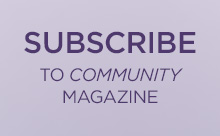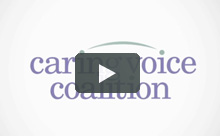Patient Association Profile

The Pulmonary Fibrosis Foundation was founded in 2000 by two brothers whose sister succumbed to the disease. What began as a local effort to figure out how to help others with pulmonary fibrosis and understand the disease has rapidly grown into a nonprofit organization with national reach.
Over the last four years, we’ve really expanded, both in terms of providing programming for patients, caregivers and their families, and by funding research. Our PFF Care Center Network and PFF Patient Registry support patients and caregivers and aid research that will hopefully one day lead to a cure.
I came to the foundation about four years ago, having served in leadership roles in other nonprofit and philanthropic organizations. It’s a bit bittersweet, because pulmonary fibrosis has directly affected my family.
Our CEO, Dr. Rose, and I felt we could take the organization to the next level. In doing that, we’ve been able to build a team that has diverse strengths, including a new medical team that joined us within the past year.
We serve patients and caregivers, but a big question within our community is, what happens when patients pass away? The PFF is there for families as well. If you’ve experienced this in your family, you ask yourself, ‘Now what?’ What does that look like after someone has passed? So a lot of folks will hold activities both in honor, and in memory of loved ones who have passed from the disease.
A huge part of what we do is getting people involved. Our volunteers hosted nearly 140 events over the past year.
My mom actually passed of it. I didn’t realize at first, because she was misdiagnosed. But by the time we found out, it was very quick. It was 10 weeks. Now, it’s six years later, and we’re still trying to sort through her medical records and see what happened.
Unfortunately, misdiagnosis happens frequently. It’s important to identify the disease as quickly as possible so that the right medical and support teams can get into place fast. Research shows that a comprehensive team helps in extraordinary ways, from improving the quality of life to even slowing the progression of the disease.
I was a pretty distracted caregiver. I had a two-year-old and a four-year-old and a dad with Alzheimer’s. I think my mother was trying to keep as much as she could to herself. I was just trying to do everything I could for all of them as well.
I bring this knowledge to the PFF when planning programs to help the overall PF community, such as suggested guidelines for Pulmonary Fibrosis caregivers, so they know they need to take care of themselves in order to help their loved ones. Our doctors often tell people to think about the oxygen mask rule on the plane—first use the mask on yourself, so that you then have the strength to help others. The same can be said for those helping loved ones with PF.
It can be challenging to do everything we would like to help support the entire community. Some of the biggest challenges include raising funds for both disease education and research.
The more we can share with the general public and the medical community about the signs of PF, the faster it can be diagnosed. We’re reaching people in a variety of ways, including live webinars and printed publications.
And the more we can fund innovative research, the closer we get to discovering a cure. We’re very proud to have earned top honors from two organizations that serve as charity watchdogs. We earned Charity Navigator’s four-star rating, and we meet all 20 of the Better Business Bureau’s Wise Giving Alliance’s accreditation standards. People know that their donations to PFF are used responsibly.
As the COO, I wear many hats, like the engagement hat, which I really love, going to see the families and the patients. We try to go out as much as possible to meet folks in person and lend our support.
In addition to administrative oversight, in a typical week, I might attend an educational event, meet with an industry partner, and talk with our medical team. I’m also always working to improve and expand our programming to better serve the PF community.
Maybe because of what I’ve gone through personally, I listen. I like to listen a lot to what experiences people have. It’s a comfort to know that you are not alone. I want to know what people need from the foundation—whether it’s support programs or educational materials or awareness bracelets.
There are different ways that people can engage with us, based on their availability and preferences. They can call or email through the Patient Communication Center (PCC) at 844-TALKPFF or [email protected]. The PCC is the central information hub for patients, caregivers, and families.
We have support groups, where sometimes patients and families find it’s more comforting or reassuring to share experiences or listen in an in-person environment.
Others may prefer online support groups, and that’s important for people who perhaps can’t get out. Online support groups are for both patients and families.
That is all complemented by our PFF Care Center Network, which provides the highest quality medical care and support services for patients and their families. Those who visit a PFF Care Center Network site have access to a multidisciplinary care team, pulmonary rehabilitation, support groups, and educational materials and programs.
First of all, it’s important for them to know that they have a resource, and that’s what we try to be. We just redesigned our website to be more user-friendly and accessible to patients, caregivers and families. We know that a lot of people, once diagnosed with PF, want more information and oftentimes visit our website to learn more.
We also offer an information kit, which includes our Pulmonary Fibrosis Patient Information Guide, which addresses topics, including defining pulmonary fibrosis, treatment and monitoring, and suggested questions to ask your health care providers. That’s also available online.
What I’ve learned in this position is that it’s very individualized. People have to know that we’re here to support them, and that we are going to listen to them. We can provide them with resources and knowledge in order to ask their physicians the right questions. They’re not alone.
It’s almost like a one-two punch. You find out that this is happening, and then sometimes you go to tell people what you have been diagnosed with, and people haven’t heard about it.
We’re working to raise awareness—this past September, we presented Global Pulmonary Fibrosis Awareness Month. We really push to get the word out, not only during the month of September, but every day of the year.
This year, one of our PFF Ambassadors, Diane Reichert, created the very successful “Blue It Up” awareness and fundraising campaign that challenged people to dye a streak of their hair blue for Global Pulmonary Fibrosis Awareness Month. The idea was to challenge others to ask, ‘What is pulmonary fibrosis?’ Kids, health care professionals, and friends jumped right in and took part, from as far away as Europe! It was a great way for people to bond globally and share knowledge.
Another important program that we have instituted this year is the PFF Ambassador Program. PFF Ambassadors are a group of caregivers, patients, and health care professionals who share their stories and provide the latest disease information to audiences around the country.
Earlier this year, we surveyed patients and caregivers and found that there is a lack of understanding about what the clinical trial experience is like. So we try to describe what the process looks like.
It’s not for everybody, but we feel that we should be there to provide information. Those who are interested in learning more about clinical trials and how to participate can visit our website at http://bit.ly/PFClinicalTrials.
We want people to know that the PFF is there for them—whether they have been newly diagnosed, or are caregivers supporting loved ones, or medical professionals who need additional information for their patients. We partner with the leading experts and organizations in the PF community to provide the best and most comprehensive resources to those who need them most.
Comments to our stories are welcomed, and are intended to offer a forum for engaging readers in the conversation. While we do not actively moderate comments, we do ask that they remain respectful and civil. Every person’s journey is unique, and each perspective is valuable to us. We will not approve comments that contain profanity, could be considered abusive, are threatening in nature, or otherwise violate the terms of our Privacy Policy. If you view a comment that seems to violate these terms, we encourage you to contact us and we will review it.














I am currently on the Lung Transplant list at Christ Hospital Oaklawn illinois. I am very frightened. On prograf and prednisone,.Every call o receive scares me more. Surgery seems do over welming. Hope i am doing the right thing! Diagnosed in 2008.Afraid of cut breaking sternum. Don’t tolerate pain at all.Also afraid of rejection!
Until I was diagnosed 3 years ago I had no knowledge of this disease. I am otherwise healthy with a strong heart, liver, kidneys, digestive tract, urinary, etc.
It was traumatic for me to learn that being a healthy 75 year old man, hunter-fisherman, outdoorsman, I was going to die a premature death.
I was still working a full time job feeling that I needed to remain productive as long as I felt strong and well.
The news that I was in the grips of a terminal, incurable disease with no hope of an Earthly future was and remains difficult for me to accept. At my age, I cannot get on a transplant list.
So I retired from active service work and now I am withering away. I have difficulty breathing and my blood O2 level is rapidly diminishing. I cannot do anything strenuous at all. My friend mows my lawn, does my home maintenance, and takes care of me and my wife like a Heaven sent son.
My hope is in The Lord Jesus Christ, and the only thing that keeps me going is the assurance of being a born again believer and of an eternal life in God’s Heaven.